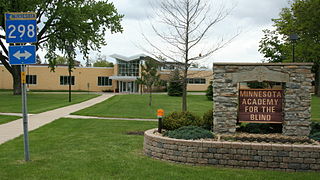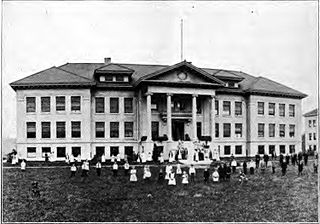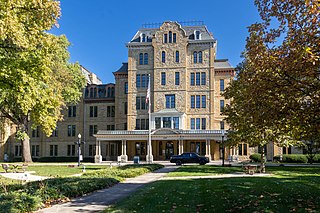Related Research Articles
The Louisiana School for the Deaf is a state school for deaf and hard-of-hearing students in Louisiana, located in Baton Rouge, the state capital. It was established in 1852 as a joint school for blind students. In 1860, its first purpose-built facility was completed and admired as an elegant monument to philanthropy. The schools were divided in 1898, and in 1908, Louisiana School for the Deaf was renamed.

The Kentucky School for the Deaf (KSD), located in Danville, Kentucky, United States, is a school that provides education to deaf and hard-of-hearing children from elementary through high school levels. Founded in 1823, it was the first school for the deaf west of the Allegheny Mountains. Jacobs Hall, its oldest surviving building, was designated a National Historic Landmark in recognition of this history.

The Minnesota State Academies are two separate schools, the Minnesota State Academy for the Blind and the Minnesota State Academy for the Deaf, both established by the legislature in 1858. The Academy for the Deaf opened doors in 1863 and the Academy for the Blind opened doors in 1866. They are public residential option schools for Minnesota children with hearing loss and vision loss, serving students from birth to age 21. They are operated by the state.

The California School for the Blind is a public educational institution for blind children, K-12, located in Fremont, California. Its campus is located next to the California School for the Deaf.
Administration Building may refer to:
Odd Fellows Hall, Independent Order of Odd Fellows Building, IOOF Building, Odd Fellows Lodge and similar terms are phrases used to refer to buildings that house chapters of the Independent Order of Odd Fellows fraternal organization. More specifically, these terms may refer to:

Oregon School for the Deaf (OSD) is a state-funded school in Salem, Oregon, United States. It serves deaf and hard of hearing students from kindergarten through high school, and up to 18 years of age.

The Minnesota State Academy for the Deaf (MSAD) is a public residential school serving deaf children in Minnesota, United States. It is one of two Minnesota State Academies in Faribault and operated by the state for particular student populations.
Main Building is a common name for a building on some university and college campuses serving as home to administrative offices, such as president or provost and may refer to:
This is an incomplete list of historic properties and districts at United States colleges and universities that are listed on the National Register of Historic Places (NRHP). This includes National Historic Landmarks (NHLs) and other National Register of Historic Places listings. It includes listings at current and former educational institutions.

St. John's College was a two-year college located in Winfield, Kansas, and was operated by the Lutheran Church–Missouri Synod (LCMS). The school began operation in 1893 under the English Evangelical Lutheran Synod of Missouri and Other States and ceased operation in 1986, after over 9,000 students had been through its programs.
William Augustus Edwards, also known as William A. Edwards was an Atlanta-based American architect renowned for the educational buildings, courthouses and other public and private buildings that he designed in Florida, Georgia and his native South Carolina. More than 25 of his works have been listed on the National Register of Historic Places.

Saint Mary's School is a private independent Episcopal college-preparatory, boarding and day school for girls in grades 9–12. Located in Raleigh, North Carolina, Saint Mary's School operates as an independent school with a historic association with the Episcopal Church including an Episcopal chapel, St. Mary's Chapel, on the school's grounds. The school formerly operated as Saint Mary's College and for many decades educated young women in grades 11–12 and their freshman and sophomore years in college. The school changed to a four year high school in 1998, at which point the name reverted to Saint Mary's School, the original name of the institution when it was founded in 1842.

The North Carolina School for the Deaf (NCSD) is a state-supported residential school for deaf children established in 1894, in Morganton, North Carolina, US.

The St. John's Lutheran College Girls Dormitory, also known as Mundinger Hall, is a historic building on the campus of the former St. John's College at 6th Ave and Gary Street in Winfield, Kansas. The main section of the Late Gothic Revival building was constructed in 1949–50. The building was added to the National Register of Historic Places in 2002.

The South Carolina School for the Deaf and the Blind is a school in unincorporated Spartanburg County, South Carolina, United States, near Spartanburg and with a Spartanburg postal address. It was founded in 1849 by the Reverend Newton Pinckney Walker as a private school for students who were deaf. The School for the Blind was established in 1855, and the school became state funded in 1856.

North Carolina School for the Blind and Deaf Dormitory, also known as the Old Health Building, is a historic dormitory building located at Raleigh, North Carolina. It was designed by the architect Frank Pierce Milburn and built in 1898. It is a 3 1/2-story, rectangular, red brick, Châteauesque style building. It features a dramatic, towered dormered roofline and measures 104 feet wide and 85 feet deep. It consists of a rectangular block with parapeted gabled pavilions, three-story engaged towers, and a three-story rear wing. It is the only remaining structure of the North Carolina School for the Blind and Deaf, now known as Governor Morehead School. After the school moved to a new location in 1923, the building housed state offices.
The Lemhi Boarding School Girls Dormitory is a historic building located on Hayden Creek Road near the community of Lemhi, Idaho. The dormitory is the only surviving building from the Lemhi Reservation, the native homeland of the Lemhi Shoshone. Due to increasing white settlement in the Lemhi Valley in the 1860s, the Lemhi Shoshone requested their own reservation; they received a reservation in 1875, though it had little arable land. A government-sponsored school opened on the reservation in 1881, but it was sparsely attended due to poor conditions and its suppression of the native culture and language. The new girls' dormitory opened in 1903 to address the original dormitory's overcrowding and poor ventilation. The dormitory did not serve the reservation for long, as the government dissolved the reservation in 1907 and relocated its residents to Fort Hall. The dormitory building later served as a Grange hall and a community center for the area.

Columbus Public Health is the health department of Columbus, Ohio. The department is accredited by the Public Health Accreditation Board. The department dates to 1833, when the city's mayor appointed five citizens to help with its cholera outbreak. It became a permanent body to activate whenever health emergencies arose.